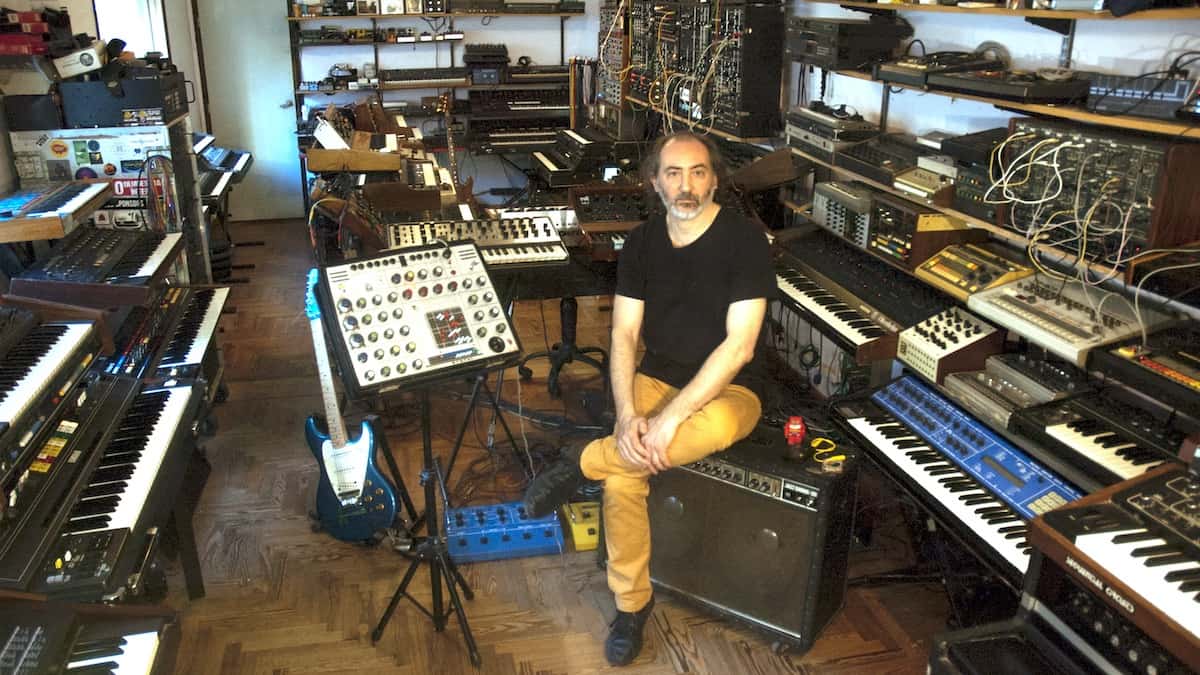In This Issue
Ernesto Romeo Answers the Question, “How Many Synths Do You Need?” Just One More…

There are wonderful musicians with massive synthesizer collections in New York, London, Paris, Berlin – but would you expect to find one in Argentina?
Ernesto Romeo, born and still based in Buenos Aires, has built up an amazing collection of electronic instruments, but more to the point has drawn many other Argentinian electronic musicians out of the woodwork. Through his

S&S: What was your initial musical training in music – classical, self-taught?
I was born in 1968. For as long as I can remember I’ve been attracted to the evocative, metaphorical, and timeless properties of some sounds heard on the records that were played in my house – Bach’s organ preludes, The Beatles’ Sgt. Pepper, full of echoes, reverberations, recordings of “extra-musical” sound sources, Indian instruments mixed with electronic keyboards and guitars, and so on. These sounds stimulated my imagination and my fantasy and “transported” me to different states.
At age ten I started listening to the radio and was surprised by the sounds and electronic resources (synthesizers, vocoders, sequencers) used in songs like Funkytown, or in songs by ELO, Alan Parsons Project, etc. In 1983, when I was 15 years old, a friend loaned me some Vangelis cassettes and listening to that music changed my life forever.
S&S: How did you first get into specifically electronic instruments?
I became a musician mainly to make music with synthesizers and electronic devices. From my first experiences with synthesizers, I realized that “keyboards” and synthesizers were two very different worlds, that the synthesizer was not a derivative of the piano and the organ and that there could be feedback and combination between both worlds. But it was immediately clear to me that the synthesizer was absolutely different from any other musical instrument.
My first synthesizer in 1988 was a Siel DK80 (a kind of Italian version of the Korg Poly800, with more polyphony and more features) but it was not what I really wanted. A couple of months later a friend lent me a simple little monophonic analog synthesizer, a Kawai (Teisco) 100F, and for me that instrument really opened the door to the magic of synthesis and electronic sound.
Between 1988 and 1989, beautiful devices such as the Roland JX8P, Yamaha CS5, Prophet 5, ARP Odyssey, Pro-One, ARP-Solina String Ensemble, Korg MS20 & SQ10, Roland MSQ700, etc. joined my set. Later I could add dream analog instruments like the Mellotron 400SM, the ARP2600, and the EMS Synthi AKS.

S&S: Which instruments did you come to like most, and why?
The instruments that fascinate me the most (some of which I feel as extensions of my body) include the Moog Modular System, the MiniMoog, EMS Synthi AKS, ARP2600, Korg MS20, and the Yamaha CS80, the most expressive, fascinating, beautiful, and ergonomic keyboard synthesizer.
(Ernesto also has more modern instruments such as the PPG and Waldorf Wave, Prophet VS and a rare Technosaurus modular synth from Switzerland.)
Now I am also exploring the Buchla universe, and I am absolutely fascinated. And the Arturia PolyBrute is a synthesizer that reached an extraordinary level of possibilities and sonic depth and complexity. And there are Argentinian synth designs many people don’t know, like Sistemas Modulares Núcleo, GS Music, and SeboSynths.
S&S: What are the special problems in running a large collection of instruments?
Maintenance is undoubtedly the main problem. Synthesizers and electronic instruments are built with margins and probabilities of failure and breakage inadmissible in traditional instruments. If we also take into account the problems of obsolescence, we see that in many ways synthesizers have more to do with the world of household appliances and consumer technology than with the world of musical instruments and crafts – unfortunately!
S&S: Have you started using Eurorack as well as keyboard instruments?
Yes, I like to build ultra-flexible systems full of personality and very portable. I build Eurorack systems by combining semi-modular instruments (Arturia MiniBrute 2, Moog Mother 32, Behringer Crave, Pittsburgh Synth Box, Antonus 2600, etc.) with various modules (in racks like the Arturia RackBrute or Antonus Sidecar), but I also like systems with the concept of a single manufacturer such as whole Nucleus or Verbos systems.
(Although Ernesto Romeo’s music is very diverse, there’s a strong rhythmic vein running through much of it, to the extent that it often sounds like techno or dance music – but perhaps more complex.)
Although I like to make music and sound art – in a broad sense – in very different ways, I have a preference for composition in real-time and interaction with sequencers, probabilistic generators, and random generators. Whether I make rhythmic music with discernible
Ernesto contributes to an international collaborative CD “Isolation” also featuring ex-members of Tangerine Dream, Space Art, Klaus Schulze’s Wahnfried
Interview extracted from the book “Synthesizers: 50 Years – The Ultimate User’s Guide” available worldwide through Amazon from 1st quarter 2021
More about the interviewer: www.markjenkinsmusic.com
















